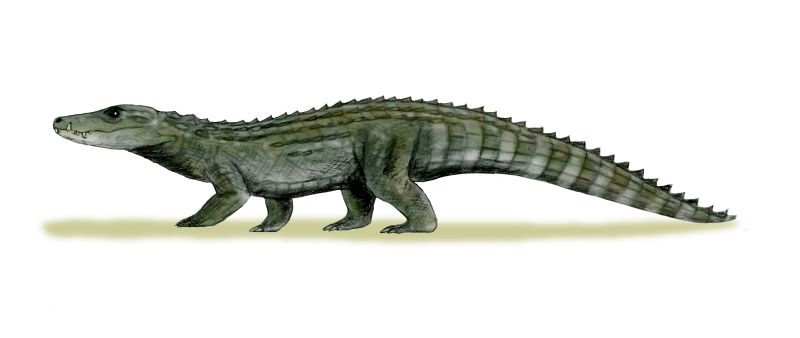[Recent Entries][Archive][Friends][User Info]
| April 14th, 2014 | ||||||||||
|---|---|---|---|---|---|---|---|---|---|---|
| 08:48 pm [industrialterro] [Link] |
Allodaposuchus Allodaposuchus is an extinct genus of eusuchian crocodylomorph and an early relative of crocodilians. It lived during the Upper Cretaceous (Campanian-Maastrichtian) in Southern Europe (Spain, Romania, and France). Like many other Cretaceous crocodylomorphs, Allodaposuchus has a relatively small body size compared to living crocodylians. The largest known specimen of Allodaposuchus belongs to an individual that was probably around 3 metres (9.8 ft) long. Allodaposuchus has a short, flattened, and rounded skull. Of the two known species, A. precedens has a brevirostrine or "short-snouted" skull with a snout about the same length as the skull table (the region of the skull behind the eye sockets) and A. subjuniperus has a mesorostrine or "middle-snouted" skull with a snout that is longer than the skull table. The main feature that distinguishes Allodaposuchus species from other related crocodylomorphs is the orientation of a groove at the back of the skull called the cranioquadrate passage; unlike the cranioquadrate passages of other crocodylomorphs, which are only visible at the back of the skull, the cranioquadrate passage of Allodaposuchus is visible when the skull is viewed from the side. The type species of Allodaposuchus, A. precedens, was named by Hungarian paleontologist Franz Nopcsa in 1928 from Vălioara, Romania. Nopcsa found bone fragments in a deposit of the Hațeg Basin that dates back to the late Maastrichtian stage - the very end of the Late Cretaceous. Several partial skulls from Spain and France were attributed to A. precedens in 2001. Some of these skulls came from Campanian-age deposits slightly older than those in Romania, meaning that the species must have persisted for about 5 million years. In 2013 a second species of Allodaposuchus, A. subjuniperus, was named on the basis of a skull from the late-Maastrichtian Conqués Formation in the province of Huesca, Spain. The skull was found underneath a juniper tree whose roots had grown between the bones, hence the species name subjuniperus or "under juniper" in Latin. The 2013 study also proposed that the French and Spanish fossils assigned to A. precedens in 2001 might actually represent a new unnamed species of Allodaposuchus currently identified as Allodaposuchus sp. A study published in 2005 had suggested that these fossils belong to several different genera of crocodylomorphs and that the original Romanian material is too fragmentary to assign to its own genus, making Allodaposuchus a nomen dubium or "dubious name". However, the 2013 study reaffirmed the Romanian material's distinctiveness from other European Cretaceous crocodylomorphs and therefore reaffirmed the validity of Allodaposuchus as a genus. Allodaposuchus is a close relative of modern crocodylians but it is not itself a member of Crocodylia, the most exclusive group including all modern crocodylians. It is an early member of a larger clade or evolutionary group called Eusuchia that originated in the Early Cretaceous. Allodaposuchus is part of an evolutionary radiation of eusuchians that happened later in the Cretaceous as they spread to multiple continents. When Franz Nopcsa named Allodaposuchus, he proposed that it was a close relative of Leidyosuchus, a crocodylian from Canada. However, Nopsca could only base this assignment on a few fragments of bone. After more complete material was uncovered from Spain and France, Allodaposuchus was reinterpreted as a non-crocodylian eusuchian in 2001. The 2001 study recognized a close relationship between Allodaposuchus and Hylaeochampsa, a eusuchian from the Early Cretaceous of England. A 2010 phylogenetic analysis supported a relationship similar to Nopsca's by placing Allodaposuchus within Alligatoroidea, a group of crocodylians that includes modern-day alligators and Leidyosuchus. Tags: Вымершие рептилии, Мел, архозавроморфы, архозавры, диапсиды, крокодиломорфы, круротарзы, мезоэукрокодилии, неозухии, равизухии, эузухии | |||||||||
| Comments | ||||||||||
| ||||||||||





![[info]](http://lj.rossia.org/img/userinfo.gif)